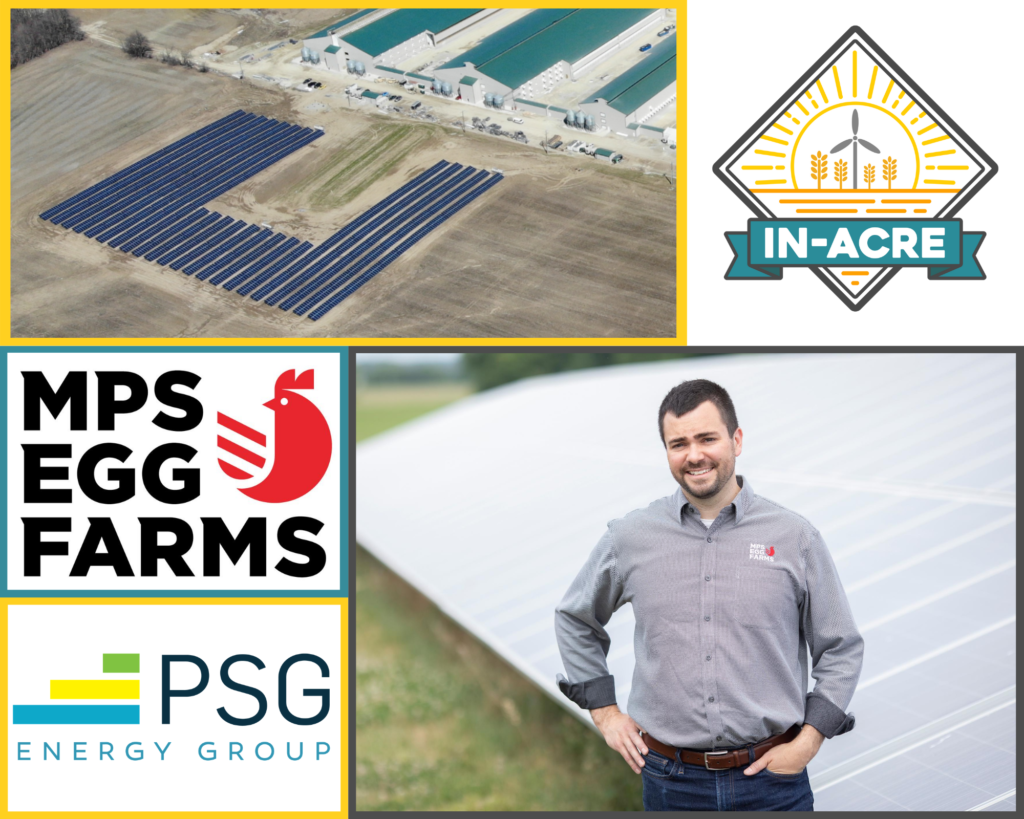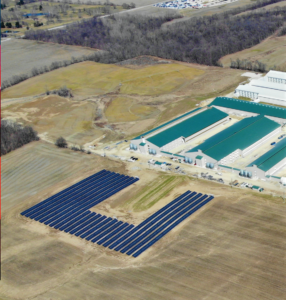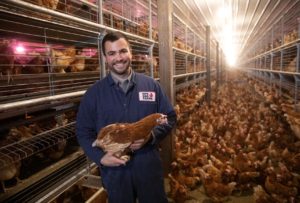Sunny Side Up: 1.1mW Solar at MPS Egg Farms by PSG Energy Group

Listen to the case study interview now and subscribe to the IN-ACRE Podcast on Anchor.fm.
The goal of this case study was to gain a better understanding of the 1.1mW ground solar array project implemented in 2019 on-site at MPS Egg Farms and managed by PSG Energy Group, what the goals were of the renewable energy project, the process and construction of the array, and a one-year introspection on the array.
Interviewer: Jasmine Eisinger, IN-ACRE Program Manager
Interviewees: Dan Krouse, Vice President of Operations at MPS Egg Farms, Jennifer Mrzlack, President of PSG Energy Group

Jasmine Eisinger: Talk to me a little bit about ground solar for the poultry barns and why MPS decided to go with solar.
Dan Krouse: MPS Egg Farms has about 11 million laying hens today in three different states. We installed 1.1 megawatt solar power system at one of our farms in Indiana. It’s been running for a little over a year now and we’ve been very pleased with its performance. We started looking at solar power a couple years before we installed it. It had always been appealing because it’s energy from the sun. What could be better than that, right? Free electricity! Except for what you pay for the panels, that’s not free. So we started looking at it and looking at the payback.
There are some real advantages to installing solar power systems with laying hen buildings, because our power consumption goes up in the middle of the day when more of our ventilation fans are running, and it also goes up in the summertime when we’re using more ventilation fans which keeps the hens cool. And that’s also what happens with solar panels. They produce more in the middle of the day when the sun is the brightest and more in the summer when the day is longer. So in that sense, solar panels, make a lot of sense for a layer farm.
We consume quite a bit of power and we have some land available at our farms, so it was possible to put in a good-sized system that eventually won’t need to rely on net metering; we can use all of the energy generated by the system right there on the farm. So those are some of the reasons that made the some of the reasons that solar was a great fit for our location in North Manchester.
JE: You anticipate being able to use all of that power and not need to net meter it back to the provider, is that correct?
DK: Right now in Indiana, we can take advantage of net metering. What that means is we can sell the power we generate to the grid, to our utility provider, get paid the same amount that we’re paying for electricity essentially. Effectively makes the grid like a free battery. We can send power to the grid, we can buy it back for what we got for it anytime we want as long as we don’t have a surplus over the course of the year.
Jennifer Mrzlack: As long as you stay with the utility, they will let surplus years roll over now, as well. So the one, the one-to-one retail net metering, and Dan did describe it pretty accurately, it is essentially the utility is your free storage so they don’t exchange the dollars, but they hold the kilowatt hours, and then they give them back at the same rate. And if this point, it does rollovers as long as you stay with the utility, and us been in a regulated electrical utility market, I’m sure you’ll be with Duke Energy for many years to come.
DK: Yeah, I’m sure we will, and they’ve been a good partner on this project and with lots of things we work with over many years. Have to extend Duke some credit there.
JM: To achieve that, you just have to make sure your interconnection application does not exceed 110% of your previous 12 months of usage, and that’s where PSG comes in to help clients. In Dan’s situation, for new barns, the energy model and the build out that you’re putting together. We helped, but it also helped that Dan and MPS Eggs had a previous relationship with Duke and had done multiple projects. So that wasn’t somebody coming out of left field saying I am going to use all this energy when this is done. They already had a trust relationship built with Duke Energy.
DK: Yeah, we’d already done some recording work a couple years prior at one of our other farms to look at power factor information. So we had some really detailed, down to 15-minute increments, information on how our barns consume power and that was helpful in making that power model.
There’s a lot more to it than just buying a bunch of panels and plugging them in. I wish it was that simple. But it’s not, so it’s great to work with somebody that knows how to make that all work and somebody that you can trust.
JE: Dan, could you talk a little bit about the decision to use the solar panels on the ground versus actually on the barns?
DK: Yeah, I can talk about why we made the choice to put them on the ground. Every installation is unique and ours certainly was. We had a fire at our farm a year or so prior to the installation of our solar panels. So we are especially sensitive to fire safety.
We initially wanted to put them on the roof because we’re putting up new chicken houses to replace the ones that are lost in the fire. There are advantages to putting panels on the roof. One, it’s space that you’re not using for anything else. Two, as long as the houses are aligned the right direction, you’ve got a big plane that’s already tilted towards the south, which is where you want to put the panels. And it’s right on top of your where you’re consuming the power, so you have less cabling needs.
But there are some disadvantages too. One of them is fire safety, and I’m certainly not saying it’s dangerous to put them on the roof, but we were doing a lot to make sure that we could isolate power to the house in the event of a fire, so we wouldn’t have to wait for the power company to come shut off the power. We knew in a fire we could isolate the house completely.
Well, with solar panels as long as the sun is shining, they’re producing power and there are systems you can put into isolate the power at the panel or at the inverter. But still, that power is there and I think because we were so sensitive to that, and because we recently acquired some land next door that was ideal for this so we decided to put the panels on the ground. One advantage is the panels can be easily isolated from the house if they need to be.
The other is ground mount is a little bit easier to install. You’re not working on a sloped surface up high and it’s easier to get to if you need to wash or service the panels. We’ve been using for a year now. We haven’t had to touch them and we probably won’t need to. So that’s a minor advantage, I’d say.

JM: I think the other advantage was when MPS chose to use the ground. In this instance, the solar arrays going into supported the new consumption load coming in. At the point that the culture houses and additional processing plant started, the construction started going in parallel. So there wasn’t a gap between when the PV was producing and when the consumption is going into place. We didn’t have to wait for everything to be complete to get our chance to go up on the roof, we were able to start the project.
Jasmine Eisinger: Jennifer, can you talk a little bit about that those concept in those preliminary steps and then what ongoing support PSG provides to this project of MPS Eggs?
JM: With any project, the first step was the utility. So again, like I mentioned, looking at the previous utility bills or understanding the energy model for the new consumption, new facilities, being built. So we did that, I won’t belabor it.
We also work with the clients to decide where in the facility or where the real estate, so it’d be the ground or the rooftop and we go through that. Typically your critical path is just the interconnection process. At that point, you’ve already sized the system to the consumption or meeting any requirements by the utility—with Duke Energy, that’s a one megawatt AC—and then specifics of the project and getting the interconnection in to make sure everything to be approved before we start the construction.
With MPS Eggs and with any agriculture project, we would take this additional step of the USDA REAP grant applications. It provides a great added value, and I know, Dan, you’ve gone through some of the reasons why they wanted to put in solar and they were committed to doing the project, but really they got the grant to be like icing on the cake for them. As far as the grant process, you have to have your grant application submitted and reviewed for completeness. So that’s usually I think that was less than a 14-day window from when we submitted it and they reviewed it for completeness. Then you can start construction. The grants are only reviewed and awarded once a year, so it doesn’t delay your construction beyond that. But had we started construction before applying for the grant, then MPS Eggs would have been ineligible for it. So that was something added that we did up front.
It required on Dan’s end we get organized, you know, specific financial information from the farms, but then it also had us a fairly vast technical aspect to the application.
DK: Yeah, I can add to that on the REAP grant application. We were successful in getting the grant, which was great. It is a fairly cumbersome application and Jennifer connected us with a consultant that could help us complete that application. So PSG assisted that consultant, and then we filled out the myriad forms that are required anytime you do something with the federal government. And we were able to get a little bit of money to help us. It improves the payback of the system, is how we’re looking at it.
It’s so important to work with somebody that has some experience there. In recent years, the REAP program has shifted. The technical limit on the project is on size of the REAP grants is much higher than what we actually earn. But their goal today is to give lots of money to lots of projects, not money to a few really big projects and then use up their whole budget. So, our consultant helped us understand how much we could apply for and stay under that limit. If we had applied for the maximum, they just would have said no. A consultant can help you be successful.
JM: Yeah, that’s important understanding because it’s a binary “yes, no,” and they won’t come back and say, oh, you’ll be awarded it, but at 50% of your ask. You either get it, or you don’t get it. So, spending the time and doing some iterations and understanding how you would score, I think it was well worth both of us engaging with the consultant.
JE: Jennifer or Dan, what has the follow-up been like? The ongoing support. I know, Dan, you had mentioned that you haven’t really needed much servicing of the panels in the last year since they’ve been implemented. But what does that look like? What can someone who’s new, or looking to implement solar expect?
DK: Well, we haven’t had to work on the panels very much but there there’s a fair amount of communication happens between Jennifer and I.
PSG helps us understand our Duke bills and where we can see the savings, because anybody that’s tried to look through their energy bills understands that they’re more complicated than they should be. And PSG is really good at helping us understand the bills and where those savings show up, and what changes once you have solar power feeding your meters.
And there are also little hitches here and there, you know, there might be a problem with the system that needs to be addressed. PSG has service people that can come address those and their response time for those little glitches has been great.
We also get a fair amount of data out of the panels that I’m always interested in watching, and PSG has been very helpful for helping get that system up and running and helping us understand how to use it.
JM: There is a data monitoring system that we included in the turnkey project and on the back end, we can see all the details that data primarily feeds from the production meter. We’ve added a consumption meter for Dan’s visibility, since these are new systems, they’re really interested in seeing how that would work. Then also, it comes in at the inverter level. So you can get alerts at the inverters. You can sometimes even drill down to a certain strain of panels through the remote monitoring, so we can dive fairly deeply into it. So we did spend time with Dan and his team and helped them set up some automated reports are different views within it to look quickly. That way, Dan can open it and see the information he wants to see.
And then on our end, we get any of those alerts and then can respond if something needs to be looked at. You can do remote troubleshooting and then sometimes we need to go in. I know, I think early on, Dan, I was running some grass and we saw one inverter was performing at about 60% of the other inverters. It was just some pieces that needed to be changed out and it was a real simple fix. So you do get a lot of insight from that monitoring system.
And then beyond that, there will be preventative maintenance and so those are the discussion we’re having now, but it is recommended once a year you do IV curve tracing from thermal drones and that can help you spot something before it becomes a problem. And what’s great about this diagnostic testing, such as the IV curves, the thermal drone analysis, is it will often detect something that it’s that issue does exist, it will support the work that you need to do an RMA (return material authorization), because the inverters have a 10-year warranty and the panels have a 25-year product and a 27-year performance warranty.
So we, the PSG team, if we’re seeing problems, we can come out and do some diagnostics that would support getting equipment replace maybe. Luckily there hasn’t been a need for that. But we do, we do keep it out.
JE: You’re really more of a long-term partner for the project.

JM: I think it’s important. It’s a big decision for somebody to make. You know, we’ve worked with Dan and we’re working with other agriculture, but we also do, you know, school districts, municipalities, and 20 years is a long horizon. Now, MPS Eggs has been a multi-generational family and can, I think Dan, you and your team are very good at looking at the long horizon, but it is something you have to weigh out. You have to really understand and make sure you have a plan when you’re talking about something that you want to see in place for the 20 to 30 years.
DK: Yeah, and it is a lot more complicated than just buying it and plugging it in like you and Jen said. There are there are things we need to take care of between us and the utility that PSG can help us with. There are regulatory issues that will change over time that PSG can help us understand. They can help us make sure we’re getting the savings on our bill, which doesn’t always work like it should. They can help us monitor our system and handle that preventative maintenance. So, it really is something that needs to be maintained over time.
JE: What do you see as not just the benefits that you’ve had already with the steam in this new barn that got put up and being able to offset that net metering but Kind of, what does the future look like for this project, future projects? PSG working with more agriculture projects like this?
DK: I think the future’s bright. I think solar panels are a great fit in agriculture, particularly in laying hen farms where our power consumption rises and falls, about the same way solar production does. It’s great on any site where you’ve got some room and you’ve got a lot of energy consumption. The price of solar panels has come down in recent years. So the payback has improved over what it used to be and will probably continue to improve. It’s a good fit! Solar power and agriculture go together well.
JM: Yeah, I would second everything Dan said, and I think that the time is now. There’s some strong incentives in place with the ITC, that’s the investment tax credit, on this at the federal level. So that is you get to net that out of your project. You have the makers depreciation. You can use bonus makers depreciation on the projects.
And then, in Indiana, you have the retail net metering. And both the ITC in the retail net metering are phasing out but they’re viable for the next few years, provides a lot of value.
As Dan has been saying, prices are dropping. I think we’ll continue to see some prices dropping and that’s why that’s the main reason why the ITC is fading out. That is a given jumpstart to the market, but as prices continue to fall and utility rates continue to rise, the project stands on its own legs more and more all the time. So it really was great time.
And then the other thing you’ll see changing, and it will be interesting, I think, to see how these next few months and then next year go with REC markets, that’s renewable energy certificates. And you get one REC for every 1000 kilowatt hours produced and the markets are becoming more dynamic. And they primarily exist because utilities have renewable standard portfolios implemented at the state level. And that’s the portion of renewables, the utility has to provide out to their wider base. The commitments they have had, it’s hard for them to keep up with their own internal infrastructure to get there. So, some day, they will be there, but to keep hitting these milestones, they’re buying from the market. And that’s another revenue stream. If a farm so chooses, they can put their RECs out into the market.
I think there was some changes recently in Ohio market where Indiana trades, and it was expected that they would the highest they would go this year was $3.00, $3.50. But I think some larger construction projects are slowing down, perhaps because the REC prices have started climbing back up and I looked at this morning, they’re trading at $8.50 cents. It’s nothing huge, but it is a revenue stream that will keep coming in.
Seeing that trend in the market, it’s happening now, right? There’s been early adopters. I’ve always said I think agriculture and farmers are a part of that early adoption. When those operations are run, you kind of understand the in and out of your business and afraid to dive into details and I guess not overwhelmed by looking at something differently, especially if it could save an operating costs Dan could speak to it much better than I can, but you can have ups and downs and agriculture and something outside of even your operations could impact the marketing cause the down. So whenever there’s an opportunity to cut your operating costs, it’s just a great opportunity to explore and implement
DK: Yes, it’s a great thing to do. It’s exciting to think that we’ve got a sixth of our power needs covered at that farm for the next 25 to 30 years.
JE: Is there anything either of you want to say, boost, plug a website or hashtag or anything you’ve got as we wrap up?
DK: Anybody that’s interested in learning more about MPS Eggs can visit our website, www.mpseggfarms.com. We’re happy to show you what we do and proud of it and happy to answer any questions if anybody wants to contact us about anything we do. I want put in a plug in for PSG. They’re a great partner and if you’re thinking about our solar power system, you should be talking to Jen.
JM: Thank you, Dan. And I say, you can visit us at PSGEnergyGroup.com as well, but can reach out to me, I’d love to talk to you and talk through any parts of MPS Eggs project, but also you know what opportunities there for you. And Jasmine, I appreciate you taking the time to spend some time with us and ask us these questions and support the renewable industry here in Indiana.
JE: Absolutely. That is what I’m here for. If you have any further questions. If you want to reach out to me, Dan, or Jennifer, we’d really love to hear your questions your success stories where you’re at in the process of implementing solar renewable energy on your farm, on your livestock barn, on your roof wherever it is, we’re here to promote that. Thank you so much for your time, folks.
—
You can learn more about implementing renewable energy projects on your land or business at www.inacre.org. We have resources, a monthly newsletter, information on becoming a member, and further links to follow this project and others.
Follow MPS Egg Farms at www.mpseggfarms.com.
Check out the many agriculture projects PSG Energy Group has and is working on at http://psgenergygroup.com/markets/agriculture/.
Note: The podcast and blog post were edited for clarity, length, and content.
